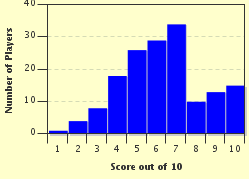Quiz Answer Key and Fun Facts
1. On returning to the hive, honey bees perform a dance which indicates the distance and direction of food. What is this called?
2. Which of the following birds does not mimic human speech?
3. The statements below explain some similarities between birdsong and human speech, but one of them is false. Which one?
4. Some dolphins have been taught to respond to humans using sign language.
5. Vervet monkeys use alarm calls to indicate the presence of different predators. Which alarm call prompts the monkeys to stand up on their hind legs?
6. How are squid believed to communicate with each other?
7. When chased by a cheetah or lion, gazelles often leap up and down. This signals to the predator that the gazelle is fit, and therefore difficult to catch. What is this behaviour called?
8. A primate named Koko was taught to communicate using a form of sign language. Koko was which of these animals?
9. When a cat rubs its chin on a human's legs, what is it most likely to be doing?
10. What is the technical term for the study of animal communication?
Source: Author
gatutkaca
This quiz was reviewed by FunTrivia editor
rossian before going online.
Any errors found in FunTrivia content are routinely corrected through our feedback system.


